The Munsterberg-Illusion
Slider
auto Animation speed / manual shift amount
Small Slider
when clicked this slider toggles play / stop
Spot 17 was inspired by a unique phenomenon amongst visual illusions which has been known for more than 100 years. H. Münsterberg [1] published it in 1897 under the title of «Die verschobene Schachbrettfigur» (The Münsterberg Figure). He said that he had not developed it himself but had found it on an American season ticket to the horse races. It appeared once again in a publication by A.H. Pierce and was called this time [2] the «kindergarten pattern». In 1973, R.L. Gregory [3] observed the tiled wall of a café in Bristol and published an article on this long-known phenomenon, calling it the «café wall illusion».
The horizontal mortar shapes between the bi-coloured courses of tiles seem to incline either to the left or to the right.
The first illusion concerns the phenomenon of the illusion of size: a light object on a dark background seems bigger than a dark one on a light background.


With this idea in mind, we create a chess board and discover that the square elements are perceived as being slightly distorted, although the dividing lines remain parallel. The dark structure blocks the light one and vice versa:

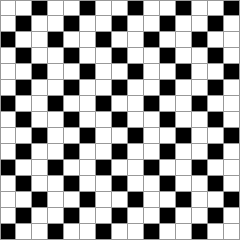
We create more scope for the illusion by reducing the number of black fields in favour of white ones. For the first time, the joints seem to incline to the left and to the right. An overlap of the same coloured fields is therefore not an essential prerequisite for the apparent slant as some authors have maintained. The light fields with three contiguous dark neighbours seem somewhat bigger, while the dark ones shrink when they border on three light ones. The illusion of size can be further developed.
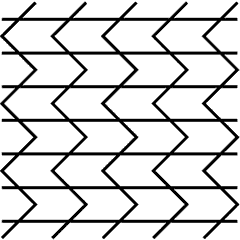
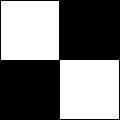
The basic module of the chessboard figure already demonstrates illusionary slanting lines. The Münsterberg figure is even more dramatic. There must be other causes for this: The dark «brick» columns have, as can be seen in the illustration above, a similarity with zigzag flashes. Horizontal lines show a definite slant on this ground. The elementary Zöllner illusion can explain this for us.
We can compare the interim result with Münsterberg's original figure:
The slant of the dividing line is more marked. If the series is reduced to two «bricks» the illusion is distinctly reduced. Thus the repetition of the module increases the effect.
Our brains cannot cope with grasping too many elements without error in a short period of time. It is well-known that the visual information on the retina is first sorted into colours, forms and lines with various basic elements and contours. An image only then appears in the visual cortex subsequent to this decomposition. It is as if the image is drawn there anew. The directions of bordering lines therefore appear only from the abstract data. The mass of rapid help programs that run parallel in the brain for the recognition of shape movement and colour can create images with errors, which tend to increase with the complexity of the encoding and decoding. This means that an intensification of the slants can be expected when the structure is continued on two axes. We show an optimised brick wall with joints by M. J. Morgan and B. Moulden [4]
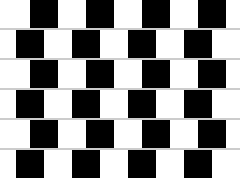
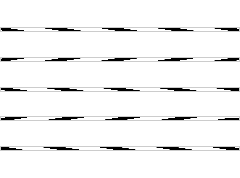
The illustration approaches a maximum which needs to be justified. The repetition of the basic module is necessary. As great a contrast as possible between the two sorts of «brick» is a second requirement. If two «brick» colours with the same level of luminosity are chosen, the illusion fails. What is it with the mortar joints?
The joints are necessary. If they are omitted, the columns of dark «bricks» clump together and reduce the slant to the minimum of the basic module.
The luminosity must be approximately the mean of the luminosity of the two sorts of «brick».
The way we visually process images in the cortex examines among other things the striking periodic structures and determines neurone activity, for example, with regard to the mortar joints. The extremes correspond with the coupled activities of the two cell types that belong to the concentric receptive fields (on-centre and off-centre cells). The top right image visualizes the maxima minima processes along the five mortar joints of the left picture.
Where two luminous «bricks» touch the joints, a minimum is created, whereas a maximum is created between dark «bricks». The elementary Fraser illusion [5] looks very similar to this abstract image and shows the same activity processes. The contribution to directional illusion in the area of the joints is thus explained to a certain extent. In our example, it is about 75%. The Zöllner illusion accounts for about 15%. Where does the missing 10% come from?